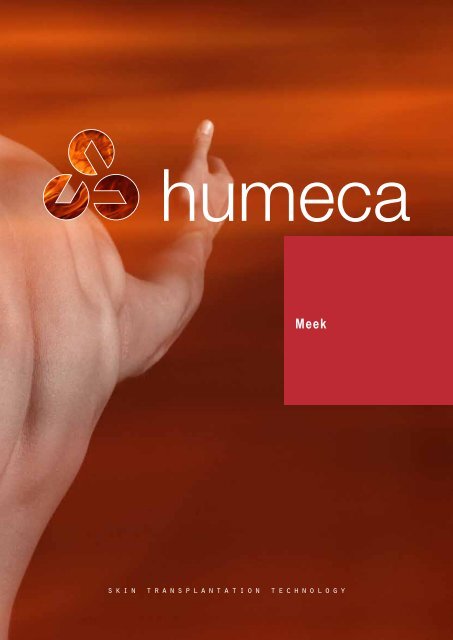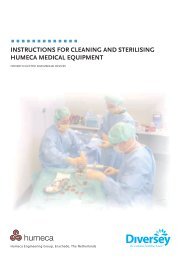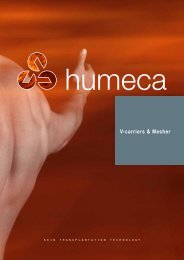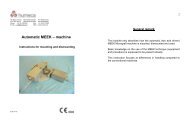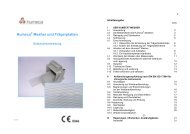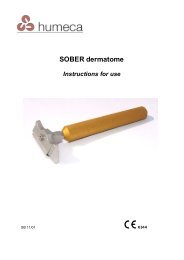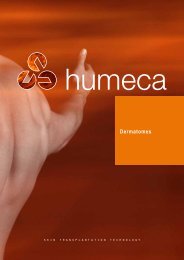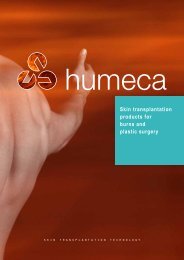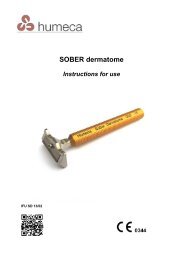Brochure MEEK Micrografting - Humeca
Brochure MEEK Micrografting - Humeca
Brochure MEEK Micrografting - Humeca
- No tags were found...
You also want an ePaper? Increase the reach of your titles
YUMPU automatically turns print PDFs into web optimized ePapers that Google loves.
Meeks k i n t r a n s p l a n t a t i o n t e c h n o l o g y1
Cork plates are covered with autograftsGauzes 1:9 applied to the back of a patientGauzes being removed 6 days post graftingGauzes removedResult shortly after complete epithelialization5
donorsite areaBurn on a shoulder, gauzes 1:6 appliedIn 1988, R. Peeters and A. Hubensof the Stuivenberg Hospital,Antwerp, Belgium, proved that theactual expansion ratio of a meshedgraft is much less than the givenone 5) . They compared the expandedgraft surface area to the originalnon-expanded graft surface area.Based on their findings we calculatedthe graft surface area required tocover a 100 cm 2 (0.11 ft 2 ) burn woundwith a meshed graft and compared itto the area required when using the<strong>MEEK</strong> technique.The result is shown in the graph.The vertical axis represents the graftsurface, while the horizontal axisshows the expansion ratio.ConclusionThe <strong>MEEK</strong> technique (with trueexpansion ratios from 1:3 to 1:9)requires only about half of the graftsurface compared to the meshgraftmethod.Consequently, in comparison with the<strong>MEEK</strong> technique, the application ofwidely meshed grafts requires moregrafting procedures in case of severeburns. A high graft take, less spillageand a better principle of expansioncontribute to the overall opinion thatthe <strong>MEEK</strong> technique is the mosteffective way to deal with the patients’skin. In an overall view, the <strong>MEEK</strong>method turns out to be less timeconsuming than meshing, especiallyin case of large burns 21) .Same burn, 6 weeks post burnWhite spots indicate anti-bacterial creamG r a f t s s u r f a c e c m 21009080706050403020100Graft surface required to cover a 100 cm 2 (0.11 ft 2 ) burnMeshgraft<strong>MEEK</strong>1 1,5 3 4 6 9Same burn, 6 months post burn6
Axilla and upper arm 21 days post burn,before operationmeek caseGauze applied to the wound (upper arm)Gauze secured with staplesBy dr. A.W.F.P. Vloemans, surgeonat Red Cross Hospital Beverwijk,The NetherlandsAn 84 years old woman was admittedin our burns centre because of a burnwound she sustained in the kitchen.While taking a kettle from the gasstove her nightgown caught fire. Atfirst she did not notice, but after awhile she saw her clothes burning.She put out the flames and cooledthe burns under the shower.On admission we saw a healthyobese woman with burns at theright upper arm, axilla and thorax.The total body surface area burnedamounted 11%; about 9 % fullthickness. The borders between fullthickness and partial thickness werenot sharp.The medical history recordedinsulin dependant diabetes and astroke. As medication she also usedacetylsalicylic acid.Topical treatment consisted of dailyapplication of Silver Sulfadiazin 1%cream dressings. Resuscitation wasapplied by means of an isotonicsaline solution and fluids ad libitum.Insulin medication was continuedbased on blood sugar levels and alsotreatment with acetylsalicylic acidwas continued.As an early tangential excision wasexpected to cause a great blood lossand as the distinction between partialand full thickness was not clear, asecondary excision and grafting afterhealing of the partial thickness burnswas performed.Operation took place on postburn day 21; five days earliertreatment with acetylsalicylic acidwas discontinued. The wound bedconsisted of granulation tissue andremainders of necrotic dermis. Debriswas excised using a dermatome.Haemostasis was performed bymeans of the application of anadrenalin solution to the excisedwound bed.A thin split thickness skin graft washarvested from the right upper leg.Ten Meek gauzes 1:6 were preparedand applied to the wound. Afterfixation with staples the wound wascovered with gauzes soaked in asilvernitrate solution. The donorsitewas dressed with polyurethane foamdressing.After 6 days the <strong>MEEK</strong> gauzes wereremoved from the wound. The grafttake appeared to be about 80%.Two weeks after the first operation,parts of the wound where the grafthad not taken because of insufficientexcision at the first operation, wereexcised again and grafted with Meekgauzes 1:4. Parts of the wound witha good graft take, but insufficientoutgrowth of epithelium were alsore-grafted.After the second operation only minordefects remained, requiring only dailyapplication of a topical antibacterialdressing. Five weeks post burn thepatient was released from hospital.Gauzes and parts of gauzes on the woundInitial result after the first transplantationRe-grafting: a gauze is cut into piecesto graft smaller areas on the thorax7
Standard hand driven <strong>MEEK</strong> machinewith single cutting blockMotor driven <strong>MEEK</strong> machinewith block shape motorMotor driven <strong>MEEK</strong> machinewith cylindrical shape motormeek productsCutting machineThe cutting machine contains 13circular blades mounted on a cuttingaxis. The cork plate with the graft isplaced in a cutting block that movesunder a bridge during cutting. Boththe drive of the blades and the driveof the cutting block can be performedby pneumatic motor or by hand.The motor drive of the blades isexchangeable with the hand driveand both can be supplied as separatesets. The drive of the cutting block isnot exchangeable; it is either motordriven or hand driven. The hand driveof the cutting block can be providedwith gearwheels for faster run of theblock. For pneumatic drive a pressureof 5-7 bar (72-100 psi) is required.The blades are coated with a durable,wear resistant ceramic layer. Thecutting axis can simply be replaced.Individual blades can also bereplaced.GauzesThe pre-folded <strong>MEEK</strong> gauze consistsof an aluminium backing and apolyamide fabric, slightly adheringto each other. After expansionthe aluminium foil is disposed of,while the fabric with the grafts isapplied to the wound. Each gauzeis supplied with a 42x42x2.5 mm(1.65x1.65x0.1") cork plate and sterilepacked in a peel pouch. Standardpackages are 10 and 40 pieces in abox. Available expansion ratios are1:3, 1:4, 1:6 and 1:9.Single cutting blockAdhesive dressing sprayThe adhesive is a spray bottle witha content of 200 ml (6.8 fl.oz).Onebottle is enough to spray 200-250gauzes.Ordering informationOrdering info for all <strong>Humeca</strong> ®products can be obtained from page11 of this brochure.Double cutting blockThe machine is supplied with a singleor a double cutting block. The doublecutting block enables simultaneouscutting of two cork plates. Single anddouble blocks are exchangeable.The machine is entirely steamsterilized, except for the motor.A sterilization case is available.Serrated wedge (‘cam’)Adhesive spraySeparate hand drive set8<strong>MEEK</strong> prefolded gauze with cork plate
Motor driven <strong>MEEK</strong> machine –automatic version with two motorsmeek features• Very small donorsites• Large expansion ratios (up to 1:9) possible• Any small skin fragments can be used; no long strips required• Graft islands are close together in a regular pattern, resulting in fast and uniform epithelialization• All graft islands are correctly orientated (dermal side down) on the wound bed, resulting in excellent graft take• Failure of a few islands does not affect the overall graft take• Actual expansion ratio equals theoretical expansion ratio• Cosmetic results are comparable with meshgrafts of a lower expansion• Grafts adhere to a fabric and are therefore very easy to manipulate when applying them to the woundmeek literature1 Meek CP, Successful microdermagrafting using the Meek-Wall microdermatome – Am. Surg. vol. 29, pp. 61 (1958)2 Meek CP, Extensive severe burn treated with enzymatic debridement and microdermagrafting – American Surgeon, vol. 29, no. 1, pp. 61-64 (1963)3 Kreis RW, Mackie DP, Vloemans AWFP, Hermans RP, Hoekstra MJ, Widely expanded postage stamp skin grafts using a modified Meek technique in combination with an allograft overlay –Burns, vol. 19 (2), pp. 142-145 (1993)4 Kreis RW, Mackie DP, Hermans RP, Vloemans AWFP, Expansion techniques for skin grafts: comparison between mesh and Meek island (sandwich-)grafts – Burns, vol. 20 (1), pp. S39-S42 (1994)5 Peeters R, Hubens A, The mesh skin graft – true expansion rate – Burns, vol. 14 (3), pp. 239-240 (1988)6 Raff T, Hartmann B, Wagner H, Germann G, Experience with the modified <strong>MEEK</strong> technique – Acta Chirurgiae Plasticae, vol. 38 (4) pp. 142-146 (1996)7 Zermani Rita, Zarabini Andrea, Trivisonno Angelo, <strong>Micrografting</strong> in the treatment of severely burned patients – Burns, vol. 23 (7/8), pp. 604-607 (1997)8 Hermans RP, Kreis R, <strong>Micrografting</strong> – Revival of an old technique – Annals of Burns and Fire Disasters, vol. 10 (1) (1997)9 Vloemans AFPM, Micrografts versus Meshgrafts – Casus10 Hadjiiski O, Method of micrografting in treatment of large area full-thickness burns – Annals of Burns and Fire Disasters, vol. 13 (3), pp. 155-158 (2000)11 Lari AR, Gang RK, Expansion technique for skin grafts (Meek technique) in the treatment of severely burned patients – Burns, vol. 27, pp. 61-66 (2001)12 Grenier de Cardenal D, Bey E, Lambert F, Duhamel P, Chaine A, Giraud O, Cantaloube D, Le procédé <strong>Humeca</strong> chez le grand brûlé: Difficultés – Brûlures, vol. III (1), pp. 34-37 (2002)13 Papp A, Härmä M, Case report: A collagen based dermal substitue and the modified Meek technique in extensive burns – Report of three cases – Burns 29, pp. 167-171 (2003)14 Kopp J, Noah EM, Rübben A, Merk HF, Pallua N, Radical resection of giant congenital melanocytic nevus and reconstruction with Meek-graft covered Integra dermal template –Dermatologic Surgery vol. 29 (6) pp. 653-657 (2003)15 Tempelman FRH, Meek <strong>Micrografting</strong> – abstract lecture16 Tempelman FRH, Vloemans AFPM, Middelkoop E, Kreis RW., The Meek-Wall Micrograft Technique. In: Surgery in Wounds, Téot L, Banwell PE, Ziegler UE, eds. Springer-Verlag Berlin Heidelberg,pp.427-434, (2004), (ISBN 3-540-22254-5, ed. 2005)17 GE Sheng-de, History of the clinic work about <strong>MEEK</strong> – Chinese Journal of Injury Repair and Wound Healing, vol. 1 (1) pp. 10-11 (2006)18 LIN Cai, CHEN Geng-xin, ZHANG Peng, et al., The <strong>MEEK</strong> technology of tiny flap graft using on extensively and deeply burning – Chinese Journal of Injury Repair and Wound Healing,vol. 1 (1) pp. 24-26 (2006)19 YANG Ding-wen, TAN Qian, WU Jie, et al., Comparison between the <strong>MEEK</strong>’s autograft and the stamp-like autograft in the clinical application –Chinese Journal of Injury Repair and Wound Healing, vol. 1 (1) pp. 30-33 (2006)20 SUN Yong-hua, ZHANG Ming-liang, ZHOU Yi-ping, et al., Transplantation of microskin Autografts and skin pulp auto-epithelium and homeoderma in the treatment of extensive full-thickness burns –Chinese Journal of Injury Repair and Wound Healing, vol. 2 (1) pp. 10-13 (2007)21 YE, Sheng-jie, PANG Shu-guang, AZHANG Wen-zhen, et al., Application experience of <strong>MEEK</strong> Skin-piece making technique on large area deep burning –Chinese Journal of Injury Repair and Wound Healing, vol. 2 (1) pp. 10-13 (2007)22 SUN, Dong-yuan, ZHANG, Hua-bin, CHEN Ji-yang, et al., Repairing of the residual wounds in major burn patients with Meek skin grafting technique –Chinese Journal of Injury Repair and Wound Healing, vol. 2 (2) pp. 113-114 (2007)23 Chun-Sheng Hsieh, Jen-Yu Schuong, W.S. Huang, Ted T. Huang, Five years’ experience of the modified Meek technique in the management of extensive burns – Burns, vol. 34, pp. 350-354 (2008)24 Lumenta DB, Kamolz LP, Frey M., Adult burn patients with more than 60% TBSA involved – <strong>MEEK</strong> and other techniques to overcome restricted skin harvest availability –The Viennese Concept – Journal of Burn Care & Research, March/April, pp. 231-242 (2009)25 S.E. James, S. Booth, P.M. Gilbert et. Al., Sprayed cultured autologous keratinocytes used alone or in combination with meshed autografts to accelerate wound closure in difficult-to-heal burns patients –Burns vol. 36, pp e10-e20 (2010).9
For ordering, please contact yourlocal dealer. You can find dealers viathe link in www.humeca.nlIf <strong>Humeca</strong> has no dealer in yourterritory, please contact <strong>Humeca</strong> forinquiry, preferably via emailinfo@humeca.nlIn order to provide <strong>Humeca</strong> quicklywith brief and most adequateinformation and to assure soonestreply, the preferred method is to fillin the contact form that is displayedwhen using the contact link in the<strong>Humeca</strong> site www.humeca.nl<strong>Humeca</strong> is a small organization withshort communication lines.This allows very quick response anda high level of service.In case of ordering or request forquotation, please refer to the articlecodes given below.ordering infomeek micrograftingEquipment3.HD/BLO<strong>MEEK</strong> cutting machine, hand driven (block model) without cutting block3.HD/CYL<strong>MEEK</strong> cutting machine, hand driven (cylindrical model) without cutting block3.MD/BLO<strong>MEEK</strong> cutting machine, motor driven (block model), without cutting block3.MD/CYL<strong>MEEK</strong> cutting machine, motor driven (cylindrical model), without cutting block3.MD/GW<strong>MEEK</strong> cutting machine, motor driven, gearwheels, without cutting block3.MD/AUT<strong>MEEK</strong> cutting machine, automatic version (two axis motor driven)3.BL38<strong>MEEK</strong> circular blade, diameter 38 mm (1.50”). Required blade diameter depends on serial number machine3.BL39<strong>MEEK</strong> circular blade, diameter 39 mm (1.54”). Required blade diameter depends on serial number machine3.CA01<strong>MEEK</strong> cutting aid 41x41 mm (1.61x1.61")3.CB01<strong>MEEK</strong> single cutting block with cork holder3.CB02<strong>MEEK</strong> double cutting block with two cork holders3.CH01<strong>MEEK</strong> cork holder3.CP4<strong>MEEK</strong> pneumatic foot pedal with connectors and hose3.GWS<strong>MEEK</strong> gearwheel drive set3.KN13/38 <strong>MEEK</strong> cutting axis with 13 ceramic coated circular blades, diameter 38 mm (1.50")3.KN13/39 <strong>MEEK</strong> cutting axis with 13 ceramic coated circular blades, diameter 39 mm (1.54")3.MAC02<strong>MEEK</strong> sterilization case 434x254x172 mm (17.1x10.0x6.8")3.MAC03<strong>MEEK</strong> sterilization case 180x51x45 mm (7.1x2.0x1.8") for the cutting axis of the <strong>MEEK</strong> machine3.RM004<strong>MEEK</strong> pneumatic block motor with connectors and coupling3.087 <strong>MEEK</strong> cylindrical pneumatic motor 2M123.SHD<strong>MEEK</strong> hand drive set3.SW01<strong>MEEK</strong> serrated wedge (cam)Disposables2.3/10 <strong>MEEK</strong> Micrograft gauze, expansion 1:3, with cork plate, box 10 pcs.2.4/10 <strong>MEEK</strong> Micrograft gauze, expansion 1:4, with cork plate, box 10 pcs.2.6/10 <strong>MEEK</strong> Micrograft gauze, expansion 1:6, with cork plate, box 10 pcs.2.9/10 <strong>MEEK</strong> Micrograft gauze, expansion 1:9, with cork plate, box 10 pcs.2.3/40 <strong>MEEK</strong> Micrograft gauze, expansion 1:3, with cork plate, box 40 pcs.2.4/40 <strong>MEEK</strong> Micrograft gauze, expansion 1:4, with cork plate, box 40 pcs.2.6/40 <strong>MEEK</strong> Micrograft gauze, expansion 1:6, with cork plate, box 40 pcs.2.9/40 <strong>MEEK</strong> Micrograft gauze, expansion 1:9, with cork plate, box 40 pcs.2.9190 Spray adhesive, bottle 200 ml (6.8 fl.oz).2.JG598STERILIT ® oil for surgical instruments, bottle 50 ml (1.7 fl.oz).10
www.humeca.nls k i n t r a n s p l a n t a t i o n t e c h n o l o g yOffice addressHet Bijvank 251-aNL-7544 DB EnschedeThe NetherlandsPostal addressP.O.Box 40175NL-7504 RD EnschedeThe Netherlands<strong>Humeca</strong> BVPhone +31 53 476 26 19Fax +31 53 477 19 05E-mail info@humeca.nl12


